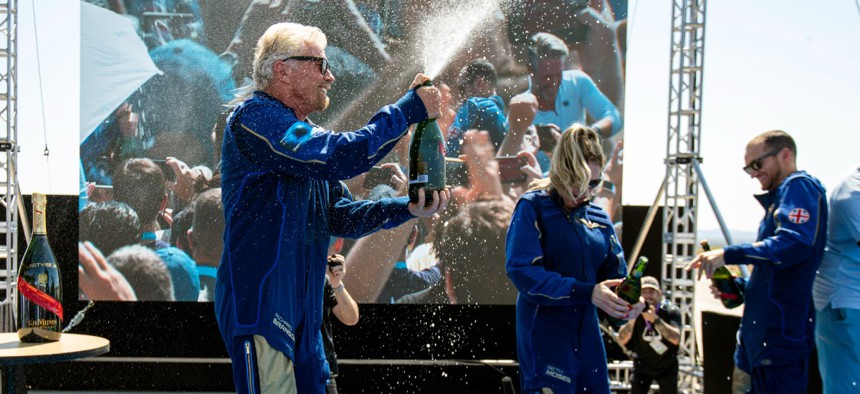NASA: Space Tourism a ‘Seminal Moment’ for Humanity

Virgin Galactic founder Richard Branson, left, sprays champagne to crew members while celebrating their flight to space from Spaceport America near Truth or Consequences, N.M., July 11. Andres Leighton/AP
Space is open for business.
Recent suborbital flights to space by Blue Origin and Virgin Galactic—and their billionaire owners and crews—may usher in another wave of transportation-related innovation similar to periods that followed the invention of railway systems, automobiles and airlines, according to NASA’s director of Commercial Spaceflight.
“It's really just another mode of human transportation and what we've seen [historically] with automobiles, rail travel and particularly airline travel—when it starts out it's very expensive and it can only be afforded by sort of the wealthy,” Phil McAlister, NASA's director of commercial spaceflight, said Aug. 18 at Nextgov’s Emerging Tech Summit. “But then over time, entrepreneurs enter that market, you get healthy competition and prices come down and safety goes up to the point where now a lot of people can afford a trip from New York to California on aircraft whereas 50 or 60 years ago that wasn't the case. I'm hoping space transportation follows that same trajectory, so to speak. No pun intended.”
McAlister, who also previewed NASA’s early plans to seek input from industry regarding next-generation destinations in space, said it was likely that as more people fly to space, “they’re not going to be content just floating around” for long. As space tourism matures, McAlister said part of NASA’s long-term vision is to “be one of the customers” of industry innovation.
Over the last six decades, McAlister said fewer than 600 people have experienced space, the vast majority of whom have been government employees. In the near future, that percentage “will likely flip,” as private astronaut missions ramp up. NASA will allow up to two private astronaut missions to dock with the International Space Station for short periods. McAlister called those missions “a good opportunity for industry to sort of get their feet wet,” and expects—years down the line—for industry to build and maintain numerous space destinations for various purposes.
“Most of these people that fly in the future on these suborbital systems will probably be civilians and a very small number of government astronauts, so I think it’s a real sort of seminal point in our history where we see a sort of democratization of space,” McAlister said. “Space doesn’t have to be the exclusive domain of space agencies like NASA and other country space agencies.”




